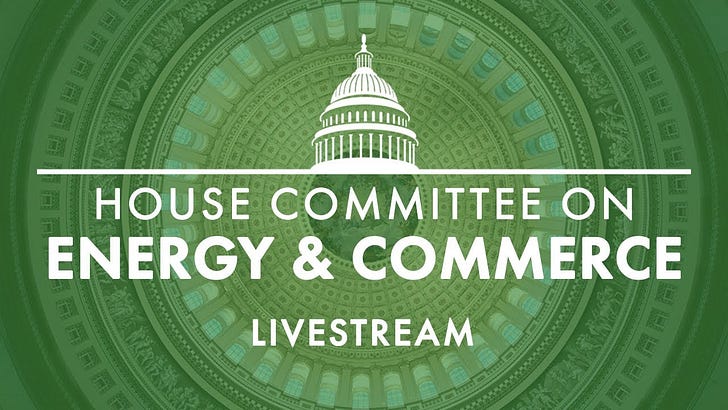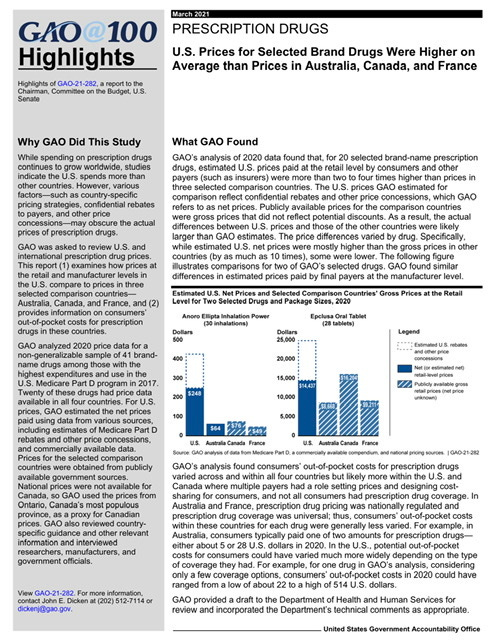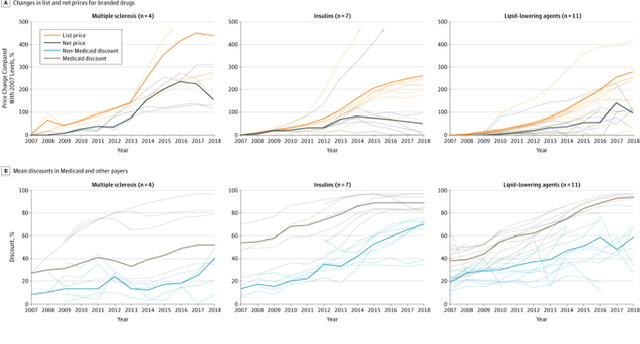Subcommittee on Health (Committee on Energy and Commerce) - hearing May 4th
“Negotiating a Better Deal: Legislation to Lower the Cost of Prescription Drugs”
May 4, 2021 Hearing - Health subcommittee
The very long awaited hearing - Negotiating a Better Deal: Legislation to Lower the Cost of Prescription Drugs
Look there really isn’t a debate that the RXs costs in America are insanely high. If you’re asking me why - my response would be tax payers fund (to the tune of billions of dollars annually) Big Pharama. We are underwriting their research and development for the very same drugs that they later sell at astronomical rates. Why? Because in the immortal words of the fictional character Gordon Gekko;
”Greed is Good”
Reports concerning Drug Prices in America
A recent study which analyzed multiple markets and drug subsets found prices in the United States were on average 256% higher - when compared to 32 other countries with comparable economies. When only comparing brand-name drugs, prices in the United States were 344% higher.
Specialty drugs and treatments for severe illnesses, like hepatitis C and certain cancers, had some of the highest prices. Currently the United States accounts for a mere 24% of the drugs sold in the compared markets - while we are responsible for over 58% of total spending.1
Government Accountability Office Report:
U.S. Government Accountability Office (GAO) found that U.S. net prices – the price after rebates, discounts, and other price concessions – for a sample of selected drugs was on average more than two to four times higher than the publicly available retail prices and manufacturer prices in Australia, Canada (Ontario), and France - the GAO also found;
the actual differences between U.S. prices and those of the other countries were likely larger than GAO estimates. The price differences varied by drug. Specifically, while estimated U.S. net prices were mostly higher than the gross prices in other countries (by as much as 10 times), some were lower. The following figure illustrates comparisons for two of GAO’s selected drugs. GAO found similar differences in estimated prices paid by final payers at the manufacturer level
Notably the GAO concluded that the disproportionate share of spending on prescription drugs, additional correlates with year- over-year prescription drug price increases in the United States. Meaning that both the list prices and net prices continue to increase at a mitch faster than the rate of inflation.2
JAMA report found:
“net prices increased every year by an average of 4.5 percentage points, or 3.5 times faster than inflation.”
Findings Using 2007-2018 net pricing data on branded pharmaceutical products in the US, list prices increased by 159% and net prices increased by 60%. Discounts increased from 40% in 2007 to 76% in 2018 in Medicaid and increased from 23% to 51% in other payers, offsetting 62% of increases in list prices for drugs.
In the event you do not have an AMA or JAMA account, I went ahead and down loaded the report (note the footer) and then uploaded it to my public drive - but I highly recommend you read this March 2021 Report in advance of tomorrow’s hearing because it will help you understand the facts and data that will be discussed at length.
Results From 2007 to 2018, list prices increased by 159% (95% CI, 137%-181%), or 9.1% per year. Whereas net prices increased by 60% (95% CI, 36%-84%), or 4.5% per year, with stable net prices between 2015 and 2018. Discounts increased from 40% to 76% in Medicaid and from 23% to 51% for other payers. Increases in discounts offset 62% of list price increases.
There was large variability across drug classes.
Multiple sclerosis treatments (n = 4) had the greatest increases in list (439%) and net (157%) prices.
List prices of lipid-lowering agents (n = 11) increased by 278% and net prices by 95%.
List prices of tumor necrosis factor inhibitors (n = 3) increased by 166% and net prices by 73%.
List prices of insulins (n = 7) increased by 262%, and net prices by 51%.
List prices of noninsulin antidiabetic agents (n = 10) increased by 165%, and net prices decreased by 1%.
List price increases were lowest (59%) for antineoplastic agents (n = 44), but discounts only offset 41% of list price increases, leading to 35% increase in net prices.
Table. Summary of 2007-2018 Changes in List and Net Prices, Overall and by Drug Class
Legislation
Linked below are the various House Bills passed by the 116th and the 117th Congress - each hyperlink will take you to the official Bill;
H.R. 3- Elijah E. Cummings Lower Drug Costs Now Act
H.R. 19 - Lower Costs, More Cures Act of 2021
H.R. 153 - Protecting Consumer Access to Generic Drugs Act of 2021
H.R. 2815 - Bolstering Innovative Options to Save Immediately on Medicines Act, also known as the “BIOSIM Act"
H.R. 2831 - Prompt Approval of Safe Generic Drugs Act
H.R. 2843 - Stop The Overuse of Petitions and Get Affordable Medicines to Enter Soon Act of 2021 - also known as the "STOP GAMES Act"
H.R. 2846 - to amend title XVIII of the Social Security Act to require PDP sponsors of a prescription drug plan under part D of hte Medicare program that use a formulary to include certain generic drugs and biosimilar biological products on such formulary, and for other purposes
H.R. 2853 - Bringing Low-cost Options and Competition while Keeping Incentives for New Generics Act of 2021, also known as the "BLOCKING Act"
Witnesses/Panel Testimony;
Therese Ball -Patient WrittenTestimony
Michael A. Carrier -Distinguished Professor of Law Rutgers Law School WrittenTestimony
Rachel Sachs - Associate Professor of Law Washington University in St. Louis, School of Law WrittenTestimony
Gaurav Gupta, M.D., M.S.E. -Founder Ascendant BioCapital WrittenTestimony
Khrystal K. Davis, J.D. - Rare Disease Caregiver & Patient Advocate Texas Rare Alliance Founding President WrittenTestimony
Other Data and Resources referenced:
January 2021 Drug Price Increases www.goodrx.com/blog/january-drug-price-hikes-2021/
Kaiser Family Foundation, Price Increases Continue to Outpace Inflation for Many Medicare Part D Drugs (February 4, 2021) www.kff.org/medicare/issue-brief/price-increases- continue-to-outpace-inflation-for-many-medicare-part-d-drugs - which found: half of all Part D-covered drugs (50%, or 1,646 drugs) had list price increases that exceeded the rate of inflation between July 2018 and July 2019, which was 1.8% (Figure 1). Among the drugs with list price increases exceeding inflation between 2018 and 2019, the median list price increase was 6.4%, or 3.5 times the rate of inflation.
List prices increased by 10% or more for 450 (14%) of all Part D covered drugs between 2018 and 2019, while more than one-third (36%, or 1,196 drugs) had price increases above the rate of inflation but below 10%. Another 13% (419 drugs) had price increases below inflation. For the remaining 38% (1,241 drugs), list prices decreased between 2018 and 2019.
Kaiser Family Foundation, Public Opinion on Prescription Drugs and Their Prices www.kff.org/slideshow/public-opinion-on-prescription-drugs-and-their-prices or via PowerPoint link https://files.kff.org/attachment/RxDrugsChartpack.pptx
Kaiser Family Foundation, Poll: Nearly 1 in 4 Americans Taking Prescription Drugs Say It’s Difficult to Afford Their Medicines, including Larger Shares Among Those with Health Issues, with Low Incomes and Nearing Medicare Age - published March 1, 2019 www.kff.org/ health- costs/press-release/poll-nearly-1-in-4-americans-taking-prescription-drugs-say-its-difficult-to- afford-medicines-including-larger-shares-with-low-incomes 3
Congressional Budget Office - CBO’s March 2008 Baseline: Medicare www.cbo.gov/sites/default/files/recurringdata/51302-2008-03-medicare.pdf last accessed May 3, 2021
Congressional Budget Office - CBO’s Medicare – CBO’s March 2020 Baseline as of March 6, 2020 www.cbo.gov/system/files/2020-03/51302-2020-03-medicare.pdf
Well now you should have more documents and data than you probably never asked for but I like to think taking the time to provide my readers with actual documents and facts is a worthwhile endeavor than stirring up Twitter drama.
Because Twitter isn’t real life. And accounts simply retweeting articles or regurgitating years old drama - exactly what value does that bring? In my opinion none and that’s why I prefer this platform. It’s quieter and more suited to getting a more fulsome discussion of things that actually matter.
Per Rand’s recent reports - www.rand.org/pubs/research_reports/RR2956.html
Inmaculada Hernandez, et al. Changes in List Prices, Net Prices, and Discounts for Branded Drugs in the US, 2007-2018 (March 3, 2020) jamanetwork.com/journals/jama/ articleabstract/2762310 - also see supplemental data - https://tinyurl.com/kw7dfhnu
Link to data and polling methodology - https://files.kff.org/attachment/Topline-KFF-Health-Tracking-Poll-February-2019












Our country, our representatives, the American people on the whole, should be ashamed of the state of medical care and prescription drug prices in the United States. We need change, that is certain, but in soooo many areas. I wish there were a way to wipe out GREED. I understand the Free Enterprise System. I also understand that rape is illegal, assault (with a deadly weapon) is illegal, in many cases, drug prices, and medical procedures costs should be considered a Crime Against A Person! Consumers NEED these goods and services to survive. If a Person cannot afford, and has to do without, a life saving drug and/or procedure, how is that NOT a Crime Against a Person?
https://bit.ly/3eVGvVW
§ 136.403 Definitions.
Crimes against Persons means a crime that has as an element the use, attempted use, or threatened use of physical force OR OTHER ABUSE OF A PERSON and includes, but is not limited to, homicide; assault; kidnapping; false imprisonment; reckless endangerment; robbery; rape; sexual assault, molestation, exploitation, contact, or prostitution; and other sexual offenses.
Reckless endangerment? uh, yeah...
Exploitation? could be... I know, this is all a stretch, but, is it? really?
In the free enterprise system, the idea is, The Government is supposed to "protect" the individual. Wouldn't part of that "protection" also be to ensure they have affordable care to ensure their good health?
Sorry, I'll stop now, but there's a lot to be considered in this argument...
I can't read this. I get so dang mad I can hardly handle it. Another thing that pisses me off beyond control - explanation of benefits (EOB). MANY times a claim is denied, which requires a written appeal. This process, including understanding your EOB, is quite upsetting for the elderly (everyone) but very hard for the elderly. My heart breaks thinking about insurance, claims and my parents, like most elderly, can't emotionally handle tasks like this.